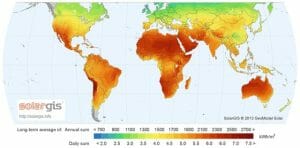Solar Irradiation Basics
Solar irradiation is the amount of electromagnetic radiation received from the sun per unit area (usually square meters). In other words, it’s the amount of the sun’s power detected by a measuring instrument. When these data are integrated over time, the information is called solar irradiation, insolation, or solar exposure. The amount of solar irradiance varies depending on how far the object is from the sun, the angle of the sun, and the solar cycle—the change in the sun’s appearance and activity every 11 years. Irradiance can be measured for the moon, stars, or any other glowing object.
Breaking solar irradiance data up into its individual wavelengths (colors) of light, also called spectral irradiance, gives scientists additional information. The irradiance of the sun is studied at several wavelengths including visible light, infrared (IR), ultraviolet (UV), extreme ultraviolet (EVU), and X-rays.
Studying spectral irradiance is important because each wavelength is absorbed in various parts of the atmosphere. For example, the radiation from visible and IR light warms surfaces like the skin and the roofs of buildings. Also, changes in solar EVU output effects space weather which is an important concern for spacecraft and space travel.
The irradiance at the top of the Earth’s atmosphere is about 1361 W/m2. After passing through the atmosphere and losing energy, irradiation at the surface of the planet is 1000 W/m2 on a clear day at sea level. The average daily irradiance of the Earth is about 6 kWh/m2. Even small changes in the sun’s irradiance can have dramatic effects on the climate, atmosphere, and ionosphere.
Applications of Solar Irradiance
Calculations using solar irradiation values are used to plan solar power systems. Most countries have insolation maps and tables for the last 30 to 60 years for use in planning. There are several solar power technologies the choose from and each uses a different portion of the total irradiation. Concentrated solar power uses only direct irradiation from the sun to generate electricity and is suitable for areas with little cloud cover. Solar voltaic panels are more versatile and use either direct or diffuse radiation.
Architects use solar irradiance to design passive heating and cooling systems for homes and buildings. Incorporating vertical windows on the side of the structure that faces the equator allows the sun’s rays to enter for heating in the winter when the sun is low in the sky. Conversely, in the summer when the sun is higher in the sky during the day, less solar irradiation enters the structure, helping to keep it cool.
Solar irradiance also plays a key role in climate modeling and weather forecasting. Scientists combine insolation data with other quantitative measurements to study how climate and weather work, what affects them and to make predictive models to project future weather conditions and changes in climate.

The image above shows the Earth’s global solar irradiation.
References
- Garner, R. (2015, April 3). Solar Irradiance [Webpage]. Retrieved May 4, 2018, from http://www.nasa.gov/mission_pages/sdo/science/solar-irradiance.html
- Solar irradiance. (2018, April 25). In Wikipedia. Retrieved from https://en.wikipedia.org/w/index.php?title=Solar_irradiance&oldid=838208993
